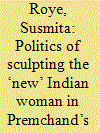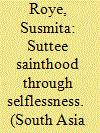| Srl | Item |
| 1 |
ID:
146877


|
|
|
|
|
| Summary/Abstract |
This article focuses on two short stories by Munshi Premchand (1880–1936), a stalwart in modern Hindi literature. The aim is to counter the growing amnesia among the general readership about Premchand’s phenomenal contribution to India’s nationalist literature and to challenge the prevailing over-simplistic analysis of his depiction of Indian and Western womanhood. It is widely understood that Premchand, as a traditionalist and nationalist, eulogised Indian womanhood, often by denigrating Western women and their ideals. Re-examining the binary between the memsahib stereotype and the Indian woman (Bharatiya nari) image, this article takes an untrodden route. Casting new light on the text, it attempts to overturn the binary model that almost all critics so far have created about Premchand’s depiction of memsahibs versus Indian women.
|
|
|
|
|
|
|
|
|
|
|
|
|
|
|
|
| 2 |
ID:
107962


|
|
|
|
|
| Publication |
2011.
|
| Summary/Abstract |
The immolation of Hindu widows has generated much horror while remaining tenaciously mixed with clandestine admiration. Reported in many eyewitness accounts and literary works, the topic has given rise to highly contested sociocultural, legal and ideological debates, strongly linked to women's rights. But the root question has not gone away: is suttee/sati just painful female victimisation or can it also reflect powerful female agency and the power of devotion? This article examines two literary works, Maud Diver's Lilamani, in which an Englishwoman unreservedly idolises a suttee, and Krupabai Satthianadhan's Kamala, where an Indian woman expresses deep pride in sutteehood. Engaging in a search for deeper meanings, this article asks what makes these two women writers revere a suttee so totally. Can one really be a suttee-saint through selflessness, or are there some deeper meanings yet to be uncovered? A wider political interpretation is suggested to re/present the root meaning of suttee.
|
|
|
|
|
|
|
|
|
|
|
|
|
|
|
|